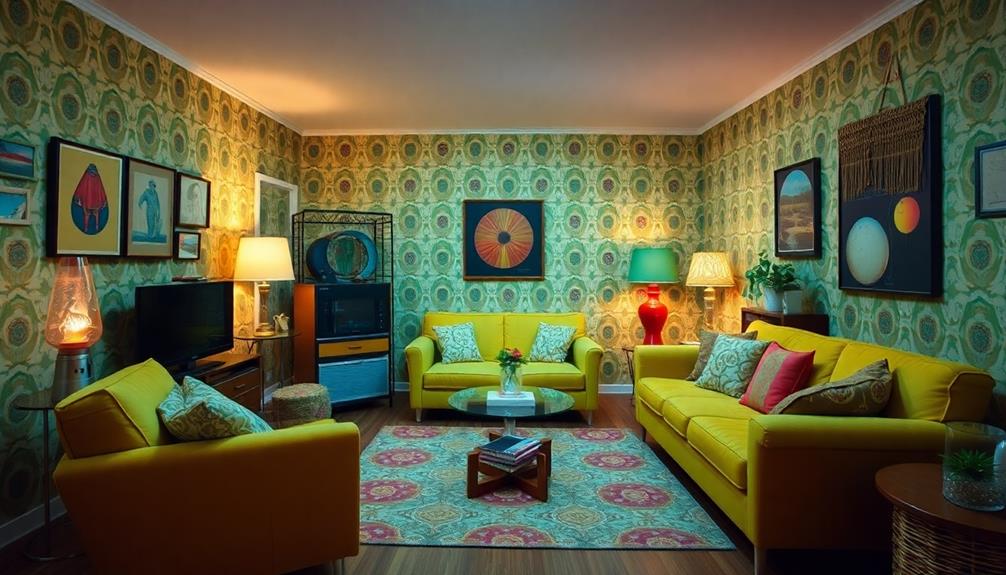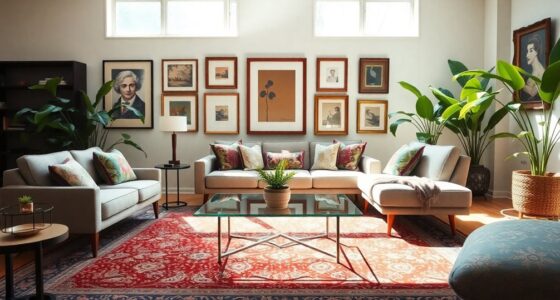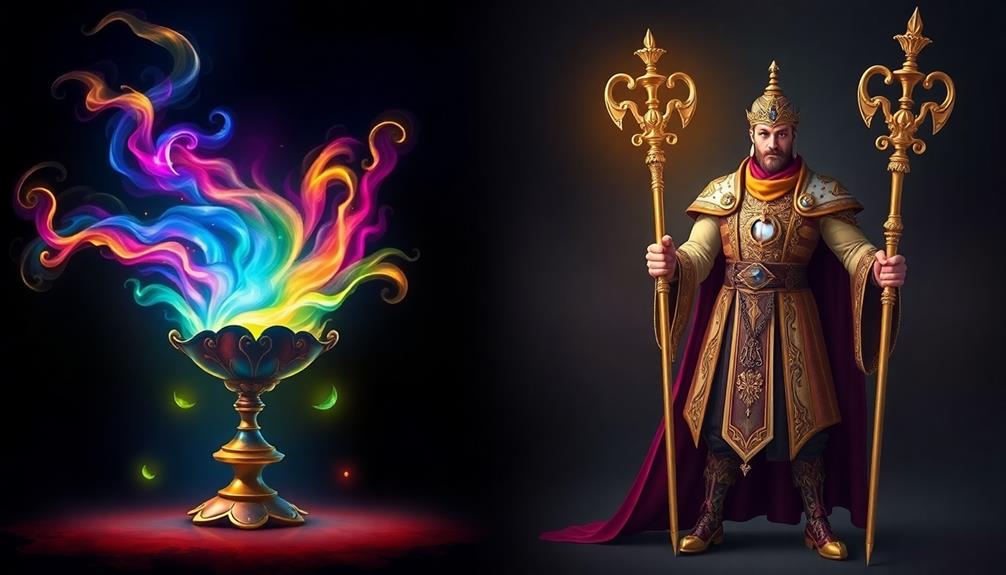Batik's vibrant patterns and intricate designs can instantly elevate your ordinary room into a cultural masterpiece. By incorporating batik textiles like pillow covers, table runners, and wall art, you'll introduce a rich tapestry of Indonesian heritage to your space. Using custom batik for curtains or lampshades allows natural light to dance across beautifully crafted motifs, creating a warm ambiance. Pair batik with traditional decor for a cohesive look that sparks conversations. Each piece tells a story, reflecting deep cultural significance. Discovering how to best integrate these elements can transform your home into a celebration of artistry and history.
Key Takeaways
- Incorporating vibrant batik textiles, like pillow covers and table runners, enhances the cultural aesthetic of any room.
- Unique batik motifs, such as Kawung and Mega Mendung, add storytelling elements to your decor.
- Using batik for curtains and lampshades introduces natural lighting while showcasing intricate designs.
- Custom batik table decor elevates dining experiences and sparks conversations about Indonesian heritage.
- Blending batik with other decor elements creates a cohesive and culturally rich atmosphere in your space.
The Art of Batik
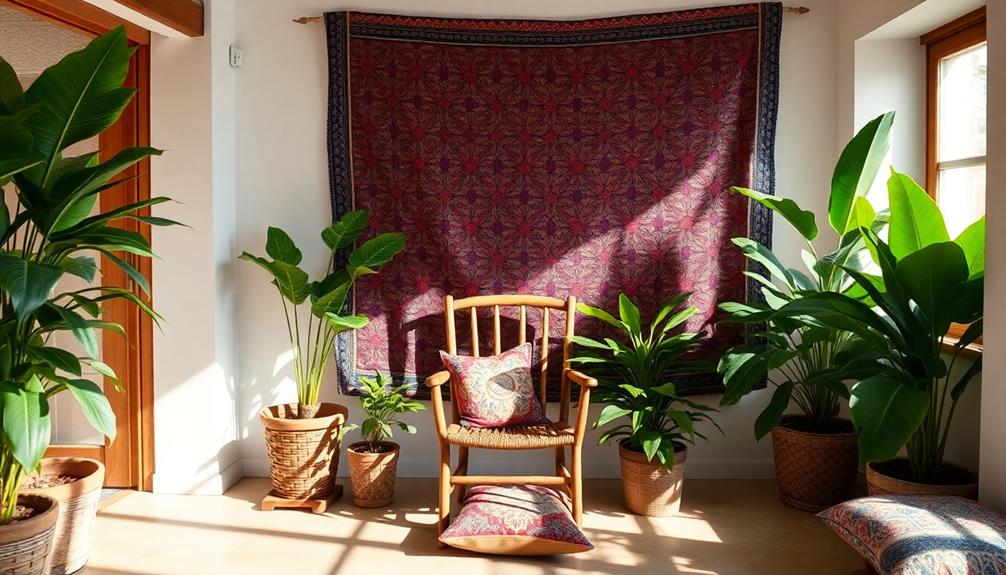
Batik is more than just a textile; it's a rich tapestry of history and culture that you can bring into your home. Rooted in Indonesian culture, batik art showcases an intricate wax-resist dyeing technique that dates back over 2000 years. Each design, like the Kawung and Parang motifs, tells a story, reflecting the diverse influences of regional cultures, religions, and natural landscapes.
The vibrant colors and intricate patterns also make batik a complementary piece to traditional Indonesian decor masks, which represent the region's rich cultural heritage and craftsmanship a must-have for cultural decor enthusiasts.
The craftsmanship behind batik is remarkable, with artisans employing either Batik Tulis (hand-drawn) or Batik Cap (stamped) techniques. Batik Tulis, being the most traditional, demands patience and skill, resulting in unique, one-of-a-kind pieces.
UNESCO recognizes batik as a Masterpiece of the Oral and Intangible Heritage of Humanity, underlining its significance and artistry.
Incorporating batik into your home decor not only enhances the aesthetic but also celebrates this vibrant cultural heritage. From wall hangings to cushions, batik can transform any space, making it a conversation starter and a tribute to the artistry of Indonesian culture.
Historical Significance

With roots that stretch back over 2000 years, the historical significance of batik is deeply intertwined with Indonesian culture. This ancient art form, primarily developed in Java, reflects a rich heritage, where traditional batik patterns were once reserved for ceremonial and royal attire.
Additionally, batik is often celebrated alongside other traditional Indonesian art forms, such as Indonesian decor masks, which also embody the country's cultural identity. Each intricate design not only showcased the skill of the artisan but also conveyed the cultural identity and social status of the wearer.
During the Majapahit empire, leaders donned batik, solidifying its association with power and authority in Southeast Asia. This deep-seated connection to history makes batik more than just a textile; it's a symbol of cultural pride.
In 2009, UNESCO recognized Indonesian batik as a Masterpiece of the Oral and Intangible Heritage of Humanity, underscoring its global importance and the need for preservation.
Today, with around 50,000 batik-producing companies active in Indonesia, this art form continues to thrive. By incorporating batik into your home decor, you're not just decorating; you're embracing a legacy of craftsmanship that has endured for centuries, enriching your space with stories and traditions that span generations.
Batik Techniques Explained

When you explore batik techniques, you'll encounter two primary methods: Batik Tulis and Batik Cap.
Both rely on the wax-resist dyeing process, where hot wax creates designs on fabric that resist dye, revealing intricate patterns once the wax is removed.
These vibrant fabrics, often handcrafted from traditional techniques, offer comfort while reflecting cultural heritage.
Understanding these techniques not only enhances your appreciation for batik but also helps you choose the perfect pieces for your home decor.
Wax-Resist Dyeing Process
The wax-resist dyeing process is a fascinating technique that transforms plain fabric into stunning works of art. In Indonesian batik, artisans use a traditional tool called a tjanting to apply hot wax onto the fabric, allowing for intricate and detailed batik designs. This method not only showcases the artisan's creativity but also reflects the rich cultural heritage and traditions of Indonesia, similar to the artistry seen in Indonesian decor masks.
Once the wax cools and hardens, the fabric is dyed; the areas covered in wax resist the dye, creating striking contrast once the wax is removed.
This process can involve multiple layers of dyeing and waxing, showcasing the artisan's skill and creativity. For example, Batik Tulis, which is hand-drawn, demands meticulous attention and can take several months to complete, while Batik Cap employs stamps for quicker production, taking just a few days. Each layer adds depth and vibrancy, resulting in complex designs that captivate the eye.
As you explore the world of batik, you'll appreciate the dedication and craftsmanship involved in the wax-resist dyeing process. Whether you choose a bold design or a subtle pattern, incorporating batik pieces into your decor can elevate your space and reflect a rich cultural heritage.
Types of Batik Techniques
Batik techniques offer a rich tapestry of artistry and tradition, each with its own unique charm. Two of the most recognized methods are Batik Tulis and Batik Cap.
Batik Tulis is the most traditional technique, where artisans hand-draw intricate designs using a tjanting tool and hot wax. This meticulous process can take months, resulting in stunning, one-of-a-kind Batik designs that celebrate craftsmanship. This intricate artistry aligns beautifully with the principles of Balinese design characteristics, emphasizing traditional craftsmanship and cultural elements.
On the other hand, Batik Cap utilizes stamped copper designs, allowing for quicker production of uniform patterns. Typically completed in just 2-3 days, Batik Cap offers a more accessible option while still preserving the essence of batik artistry.
Additionally, there's Batik Lukis, a modern painting technique that gives artists the freedom to express their vision while honoring traditional practices. Each technique showcases unique artistry, with UNESCO recognizing both Batik Tulis and Batik Cap as cultural masterpieces, highlighting their importance in preserving heritage.
When choosing a batik piece for your home, consider how the technique affects the cost and complexity. Batik Tulis is generally more labor-intensive and expensive, while Batik Cap offers a budget-friendly alternative without compromising on beauty.
Unique Motifs and Patterns
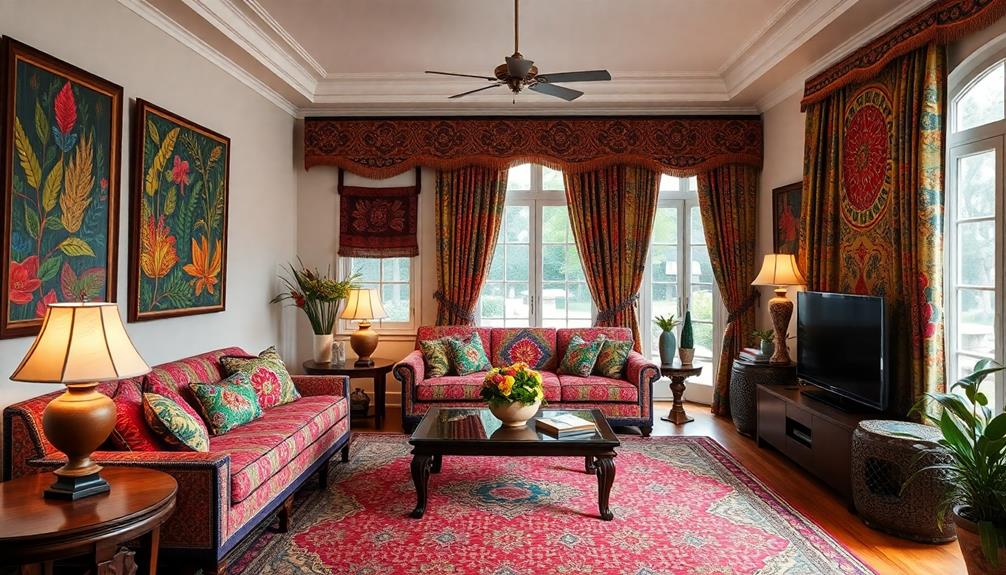
In the world of home decor, unique motifs and patterns found in batik can transform your space into a vibrant cultural tapestry. Each piece of batik fabric tells a story, showcasing intricate patterns that reflect Indonesia's rich cultural heritage and diverse architectural styles, which are often represented in these designs.
For instance, the Kawung motif symbolizes human life, while the Mega Mendung pattern promotes calmness. You'll find that the Parang motif, representing continuity and ocean waves, was historically worn by leaders, and the Sido Asih design is traditionally associated with Javanese weddings.
Each artisan's region contributes to these unique motifs, with Balinese batik often featuring designs inspired by local culture, like peacocks and traditional dancers.
These intricate patterns aren't just beautiful; they carry symbolic meanings as well. Sidomukti signifies happiness, while Sido Luhur represents goodness, adding depth to your decor.
The vibrant colors achieved through natural and synthetic dyes enhance these unique motifs, making batik fabrics a stunning choice for your home. By incorporating these elements, you'll not only beautify your space but also celebrate the artistry and stories behind each design, embodying the cultural significance of housing in Indonesia.
Transforming Spaces With Batik
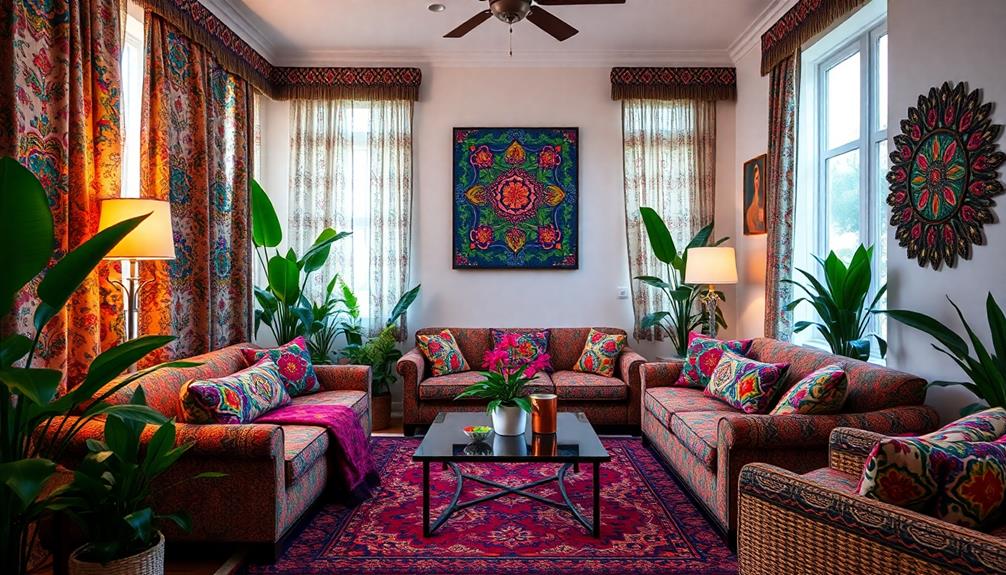
Transforming your living space with batik can bring a fresh, cultural vibe that resonates with warmth and creativity. You can start by incorporating batik textiles, like vibrant pillow covers and table runners, which instantly add a touch of traditional Indonesian art to your home.
Consider blending these textiles with other Indonesian decor elements, such as traditional lanterns and candles, to create a cohesive and inviting atmosphere. If you're looking for striking focal points, consider batik wall art, whether framed pieces or canvas paintings, showcasing intricate patterns and colors unique to different types of Indonesian regions.
Using batik fabric for curtains and lampshades can enhance your natural lighting while introducing cultural motifs that reflect your personal style.
Don't overlook custom batik table decor, like placemats and coasters, which not only elevate dining experiences but also spark conversations about the rich heritage behind the designs.
Incorporating batik into home accessories—such as decorative baskets or photo frames—creates a cohesive and culturally enriched aesthetic throughout your space.
Contemporary Applications
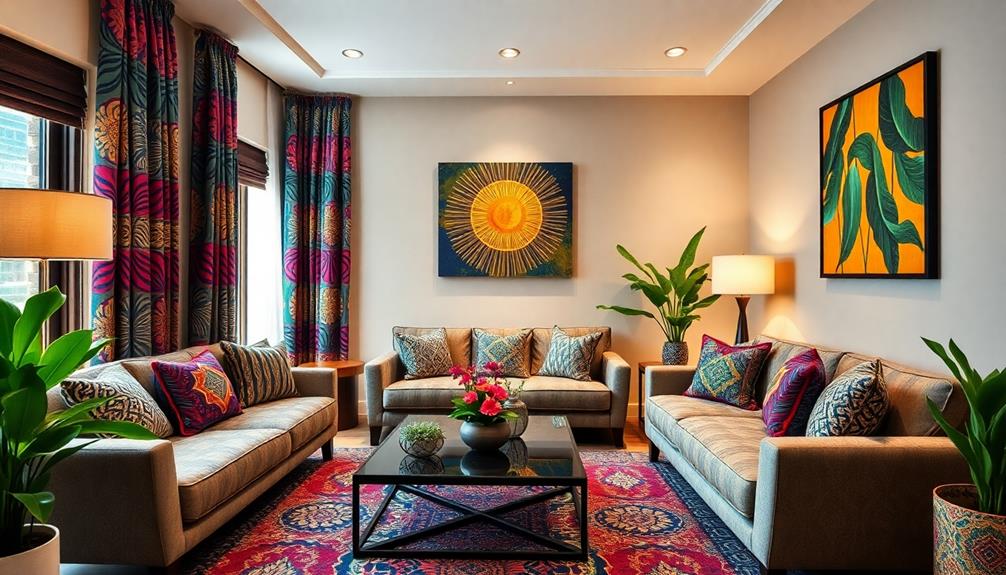
You can easily embrace modern batik fashion trends and incorporate them into your home decor.
By using traditional Indonesian style home decor elements, think about adding batik throw pillows or unique lampshades to create a vibrant atmosphere that blends tradition with contemporary style.
Modern Batik Fashion Trends
Modern batik fashion trends are redefining how traditional textiles are perceived and worn today. Designers are skillfully blending classic motifs with contemporary styles, making batik a staple in both streetwear and high fashion.
This dynamic shift not only elevates the batik industry but also appeals to a global audience seeking unique, sustainable fashion choices. Additionally, the use of batik aligns with the growing interest in incorporating sustainable and eco-friendly materials, further enhancing its relevance in modern decor and fashion.
Here are four key aspects of modern batik fashion trends:
- Versatility: Batik fabrics are now seen in dresses, shirts, and accessories, showcasing their adaptability.
- Sustainable Practices: The rise of eco-conscious consumers drives demand for handmade batik, promoting local artisans and preserving cultural heritage.
- Collaborative Innovation: Partnerships between traditional artisans and modern designers result in fresh, innovative designs that resonate with younger generations.
- Increased Visibility: Fashion brands are incorporating batik prints into seasonal collections, enhancing their appeal and recognition worldwide.
Batik in Home Decor
Batik in home decor brings a vibrant cultural richness that can instantly elevate any living space. You can easily integrate this stunning art form through various elements. For instance, consider vibrant table runners, coasters, and placemats, which add a culturally rich aesthetic to your dining settings.
These dyed fabric pieces introduce intricate patterns that spark conversation and admiration, much like the luxury tropical design aesthetics offered by boutique interior shops in Bali.
In your living area, using Batik fabric for pillow covers allows for a mix-and-match approach, creating visually dynamic and personalized accents. You'll find that Batik lampshades provide unique lighting effects, transforming the room's ambiance while showcasing the beautiful designs.
Additionally, using Batik fabric for curtains not only adds a colorful touch but also enhances the overall design theme of the room, becoming a striking focal point.
You might also craft decorative items like photo frames and storage baskets from Batik, offering a way to display artful designs while maintaining functionality in your home decor.
Supporting Local Artisans
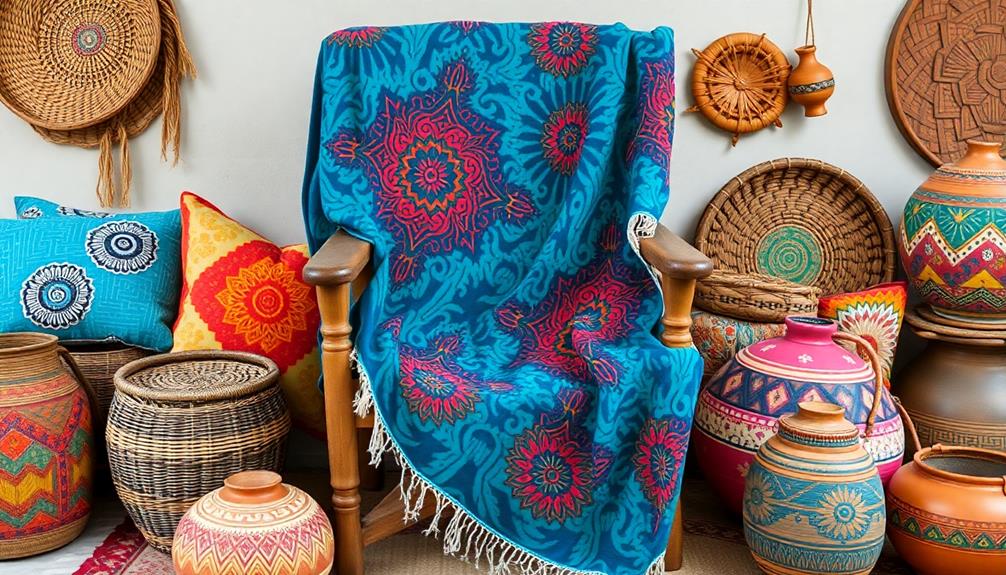
Supporting local artisans in batik production not only helps preserve traditional techniques but also enriches cultural heritage. By supporting these skilled craftsmen, you're directly contributing to the sustainability of this vibrant art form, ensuring it thrives for generations to come.
Here's why it matters:
- Cultural Preservation: Each piece of batik reflects Oral and Intangible Heritage, showcasing unique stories and histories.
- Economic Support: With around 50,000 batik-producing companies in Indonesia, your purchases bolster the local economy, providing fair compensation to artisans.
- Eco-Friendly Practices: Initiatives like the Clean Batik Initiative promote sustainable methods, encouraging artisans to adopt eco-friendly practices, enhancing their marketability.
- Global Market Access: As interest in batik increases, local artisans gain opportunities to share their designs and cultural narratives with a wider audience.
Frequently Asked Questions
What Is the Cultural Significance of Batik?
Batik's cultural significance lies in its rich symbolism and heritage. You'll discover that each motif tells a story, connecting you to traditions and rituals, while celebrating the artistry that's been passed down through generations.
What Is the Importance of Batik in Art?
Batik's essential in art because it showcases intricate techniques and cultural stories. You'll appreciate its unique patterns and meanings, discovering how it connects communities and preserves heritage while inspiring contemporary creativity across various artistic fields.
What Is Batik in Cultural and Creative Art?
When it comes to cultural and creative art, batik weaves a rich tapestry of tradition and storytelling. You'll see how its intricate designs reflect heritage, connecting you to the vibrant history and artistry of Indonesia.
What Does Batik Symbolize?
Batik symbolizes cultural identity, heritage, and spiritual connections. Its intricate patterns convey stories and beliefs, reflecting the essence of Indonesian communities. When you explore batik, you're connecting with generations of artistry and tradition.
Conclusion
By weaving batik into your home, you're not just adding decor; you're inviting a tapestry of culture and history to flourish in your space. Each vibrant motif tells a story, transforming your ordinary room into a canvas of tradition and artistry. As the patterns dance across your walls, they symbolize the connection between past and present, breathing life into your environment. Embrace batik and watch your home evolve into a vibrant masterpiece that resonates with heritage and creativity. Embracing batik also means embracing the intricate craftsmanship behind each unique pattern. The process of creating batik involves a technique known as the wax-resist dyeing method, where artisans meticulously apply hot wax to the fabric in order to create intricate designs. By incorporating this unique batik pattern hack into your home, you’re not just decorating, you’re honoring the dedication and skill of the artists who have passed down this tradition through generations. Each piece of batik becomes a testament to the rich cultural heritage and the enduring creativity of its creators.

